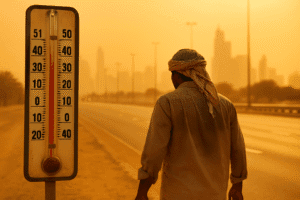Beyond the Thermometer: UAE’s Historic Heatwave and the Human Cost of Rising Temperatures
The UAE is enduring a severe and historic heatwave, with the desert town of Sweihan hitting a scorching 51.8°C (125.2°F) on August 1st – the nation’s highest temperature since 2021. Crucially, this peak follows months of relentless heat: interior regions baked under temperatures exceeding 50°C daily throughout June and July, while coastal giants like Dubai and Abu Dhabi faced stifling highs near 45°C.
Although slightly below the all-time record of 52.1°C set in 2002, the extreme heat’s persistence is alarming. Forecasts warn the danger won’t relent, predicting August temperatures 0.25-0.5°C above average. This intense heat poses severe health risks, forcing authorities to urgently warn residents against sun exposure, especially midday. Beyond the staggering numbers, the event starkly highlights the immense human and infrastructural strain caused by increasingly extreme weather patterns.

Beyond the Thermometer: UAE’s Historic Heatwave and the Human Cost of Rising Temperatures
The United Arab Emirates isn’t just experiencing summer; it’s enduring a relentless, record-breaking heatwave pushing human resilience and infrastructure to their limits. While deserts are synonymous with heat, the intensity and duration witnessed this year are painting a stark picture of a changing climate.
The Scorching Reality:
- Peak Temperature: On August 1st, the desert town of Sweihan recorded a blistering 51.8 degrees Celsius (125.2 degrees Fahrenheit), the highest temperature seen anywhere in the UAE since 2021.
- Unrelenting Interior Heat: Throughout June and July, temperatures in the UAE’s vast interior regions consistently soared above 50 degrees Celsius every single day, creating an environment where outdoor activity becomes hazardous.
- Coastal Intensity: Even coastal megacities like Dubai and Abu Dhabi haven’t been spared, experiencing temperatures hovering around a stifling 45 degrees Celsius (113 degrees Fahrenheit).
- Historical Context: While intense, this recent peak still sits just below the UAE’s all-time high of 52.1 degrees Celsius (125.8 degrees Fahrenheit), recorded in Sweihan back in July 2002. However, the persistence of extreme heat this season is alarming.
A Summer Far From Over:
The UAE’s National Center of Meteorology (NCM) delivers sobering news: this extreme pattern isn’t breaking soon. Forecasts indicate the remainder of the summer will be significantly hotter than average, with August temperatures predicted to be 0.25 to 0.5 degrees Celsius above normal. This seemingly small increment translates to tangible, dangerous increases in heat stress on both people and the environment.
The Human Impact: More Than Just a Number
Behind the staggering statistics lies a profound human challenge:
- Health Crisis: Extreme heat is a direct threat to life. Risks of heatstroke, dehydration, and cardiovascular strain skyrocket. Vulnerable populations – outdoor laborers, the elderly, children, and those with pre-existing health conditions – face disproportionate danger.
- Lifestyle Disruption: The simple act of moving outdoors becomes a calculated risk. Traditional daily rhythms are disrupted. Essential outdoor work, particularly in construction, agriculture, and delivery services, becomes perilous, forcing schedule shifts or work stoppages.
- Infrastructure Stress: The grid faces immense pressure from constant air conditioning demand. Road surfaces can soften, and water resources are stretched thin. Urban “heat islands” exacerbate temperatures in concrete-dominated areas.
- Economic Costs: Productivity dips across outdoor sectors. Energy consumption soars. Healthcare systems see increased demand due to heat-related illnesses.
Urgent Warnings and Necessary Adaptation:
The NCM’s repeated warnings carry grave weight: Avoid unnecessary sun exposure, especially during peak afternoon hours (typically 11 am to 4 pm). Staying hydrated is non-negotiable, not optional. This advice isn’t merely about comfort; it’s about survival.
A Broader Lens: Climate Change’s Fingerprint
While the UAE has always experienced hot summers, the increasing frequency and intensity of these extreme heatwaves align with global climate change trends. The 51.8°C record in early August, following two months of relentless +50°C days, is a potent data point in this worrying trajectory. It forces crucial questions about long-term adaptation strategies, urban planning for extreme heat, worker protections, and the global imperative to mitigate further warming.
The Takeaway:
The UAE‘s current heatwave is more than a weather report; it’s a visceral experience of escalating climate extremes. The 51.8°C in Sweihan is a stark marker, but the true story lies in the sustained, dangerous heat impacting millions daily. It underscores the immediate need for protective measures for residents and workers, while simultaneously serving as a powerful reminder of the urgent, global climate action required to prevent such extremes from becoming the unmanageable norm. The desert nation’s struggle with unprecedented heat offers a sobering glimpse into a future many regions may increasingly face.
You must be logged in to post a comment.